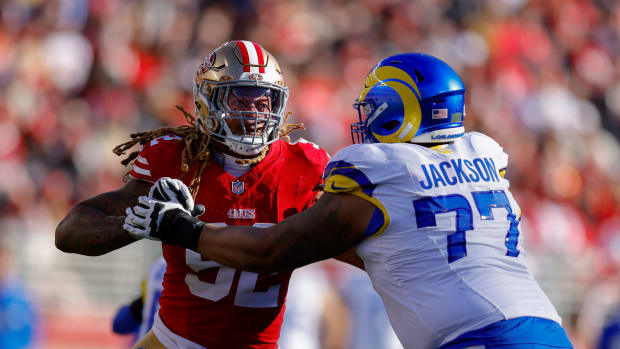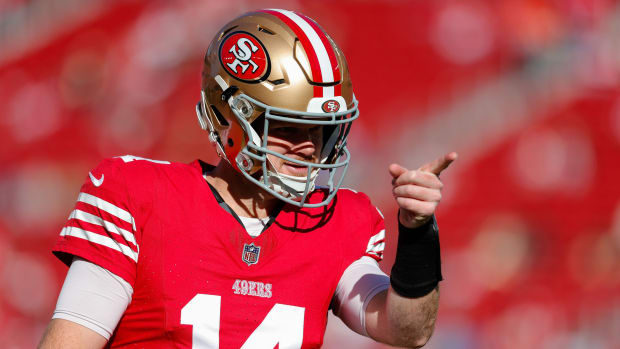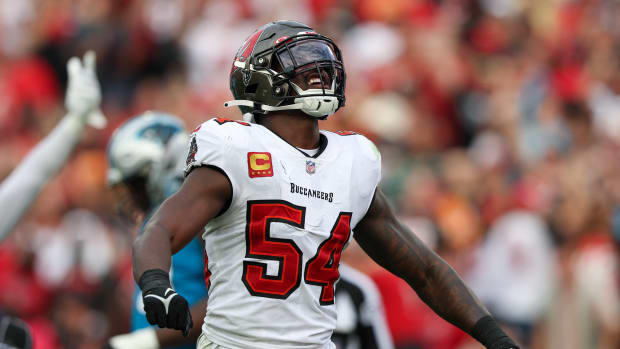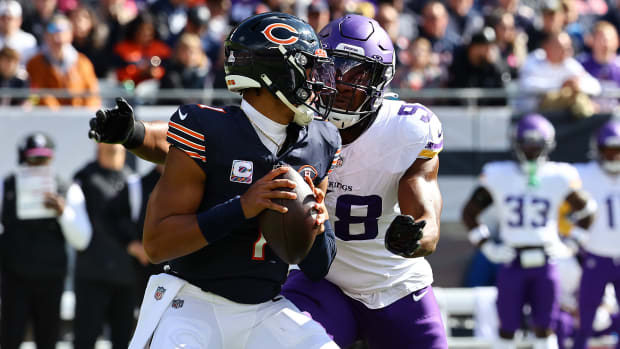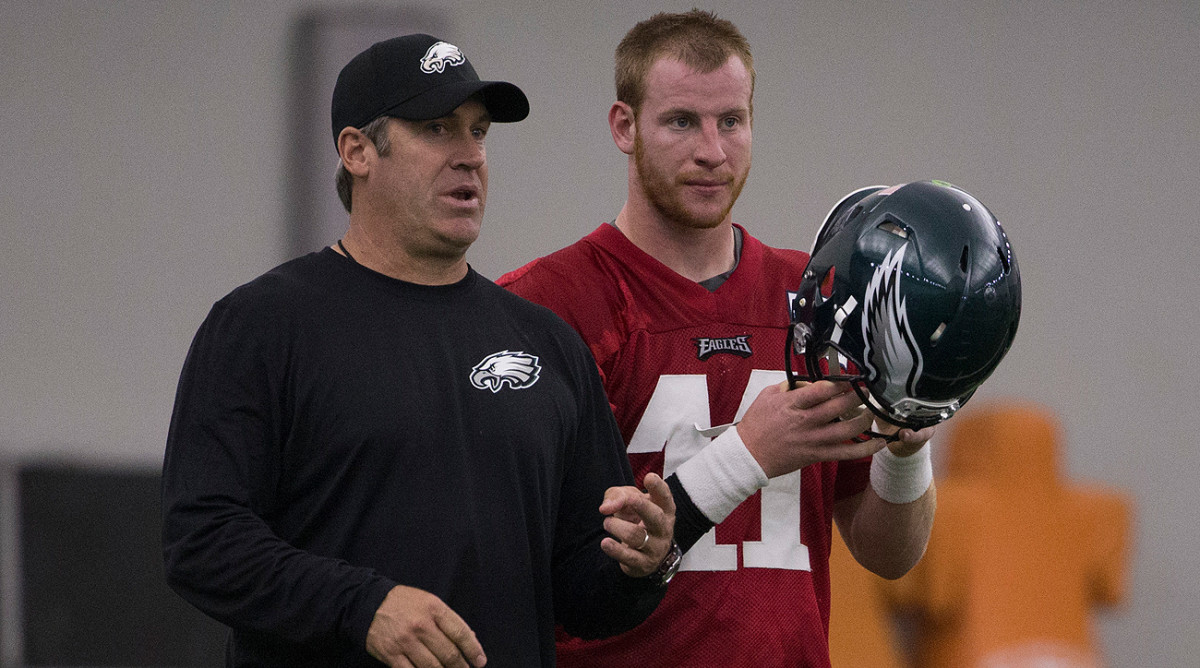
Emotional Intelligence and How the Eagles are Faring
Jeffrey Lurie delivered one of the most memorable lines of last season when he said he wanted the next Eagles head coach to have “emotional intelligence.” The owner’s quote came at his December press conference, after the team had decided to fire Chip Kelly at the end of his third season. Philadelphia’s search for a new head coach led them to Doug Pederson, a former backup quarterback and assistant coach for the organization under Andy Reid.
It’s now about four months into Pederson’s tenure, so I asked Lurie last week how he felt his new coach was faring in terms of “emotional intelligence” and “opening his heart” to players, another criterion he mentioned in December.
“Doug is doing a great job,” Lurie said at the league meetings in Charlotte. “He is communicating great, respects everybody he is in communication with. The players, I think, really gravitate toward him, in a human way. In a real, human way, not just an employee-employer type of way. And that’s important. Players play for passion, they play with passion and they want passion and great interaction.”
Lurie also praised Pederson for being smart, knowing the offense like the back of his hand, and assembling a good staff, including bringing in defensive coordinator Jim Schwartz and retaining special teams coordinator Dave Fipp. A strong coaching staff, Lurie says, was “one of the prerequisites” for the first-time head coach. “And Frank Reich and John DeFilippo are terrific quarterback coaches,” Lurie added, “which is why, with our investment in quarterbacks, we surrounded them with real good people.” (Reich is the offensive coordinator and DeFilippo is the quarterbacks coach, but Lurie’s point was that both men know how to coach quarterbacks).
Part of the reason I asked Lurie for an early review of Pederson’s “emotional intelligence” as a new head coach was because he’s already had a big test of that, navigating a sticky situation when Sam Bradford skipped two weeks of voluntary offseason workouts after the Eagles traded up to draft Carson Wentz. But all three quarterbacks—Bradford, Wentz and Chase Daniel, signed to be a veteran backup—are now back in the NovaCare Complex, learning the new offense during organized team activities.
“I think we’re navigating it well,” Lurie said.
In MMQB on Monday, I used a quote from Lurie explaining why the Eagles view their quarterback situation differently than others might. I included it as an item in the 10 Things I Think I Think, and didn’t get to fully expand upon the point Lurie was making, so I wanted to take the opportunity here.
The Eagles signed Bradford to a two-year, $36 million contract this offseason. When Lurie said last week, “We see Sam as absolutely the right guy to quarterback the team,” I interpreted that to mean in the here and now. Otherwise, they would have signed him for longer than two years.
Lurie then went on to say the Eagles are “so rarely able to draft in the Top 5 in the draft. It’s only been twice in about 15, 20 years.” Before the Eagles made the moves to jump up from No. 13, to No. 8, to No. 2, in order to nab one of the top two quarterbacks in this year’s draft, they had only picked in the top 5 twice in the past 17 drafts: QB Donovan McNabb at No. 2 in 1999, and tackle Lane Johnson at No. 4 in 2013. “We had to make the move to secure having a potential franchise quarterback for many, many years,” Lurie added.
Really, what the Eagles did comes down to an organization not wanting to be caught without a quarterback. After signing Bradford; and then signing Daniel to a three-year, $21 million contract; and then sending five draft picks to Cleveland, including a future first- and second-rounder, to vault to No. 2 and select Wentz, people questioned whether or not the Eagles actually had an offseason plan. Well, their plan simply was to not get caught without a quarterback. They spent a heck of a lot of resources to do it, but basically, their thinking was, it won’t matter if we spend these resources on other parts of the roster if we don’t have a quarterback.
As Lurie put it, “That’s how I look at it: You either have a really good quarterback and you compete for the Super Bowl, or you don’t and you are probably not competing for the Super Bowl. That’s simple.”
Now, the rest is up to the coaches. Can they get Bradford to play at a level that matches his contract, while developing Wentz, while maintaining harmony in a quarterbacks room that already sustained some cracks during Bradford’s mini-holdout? The truth is, even if you navigate a tricky situation as well as possible, things might not work out as well as you’d like (see: Broncos). But emotional intelligence would sure come in handy.
And now for your email...
* * *
ON VEGAS POPULATION
Just one quibble, on the Las Vegas piece. Asking if “a city of about 600,000 can support a local fan base” is like asking if East Rutherford, NJ (population less than 50,000) can support two teams. What is relevant when evaluating the ability to support an NFL team is the size of the metropolitan area, not the size of one city or town in which the stadium might be located. Las Vegas’ metro area has over 2.3 million people (and growing). I understand the NFL needs to make sure there is enough interest in the Las Vegas area to support a franchise, but the relevant number as a starting point is not 600,000—it’s 2.3 million.
—Steve T.
Thanks for the note, Steve. You are correct; instead of citing the population of just the city of Las Vegas, I should have included the number for the metropolitan area, which according to the U.S. Census Bureau 2015 population estimates, is about 2.1 million. But even so, you can see where the NFL might have some concerns. The Raiders would be moving from the Bay Area to a market less than 50 percent the size. Even though Vegas’ metro area is larger than that of seven current NFL teams according to those Census numbers—Chiefs, Browns, Colts, Titans, Jaguars, Saints and Bills—owners would naturally not be jumping at the chance to move a team from a Top 11 market to one that ranks 29th. Plus, the population tends to be more transient, and you’re competing with casinos who don’t want people to leave their property. All that makes it harder to build a fan base. Not saying the move won’t happen—if the state legislature approves the $750 million in public funds for a new stadium, I think that would be the biggest factor for the push to Vegas. But every metro area needs to be market-tested, particularly one on the smaller end of the NFL spectrum.
LAS VEGAS CONSPIRACY?
In regards to your column, why is it not thought of that there could be a huge domino effect to make this happen. Follow me here:
1. The Rams don't want the Raiders in LA
2. Chargers don't want them in LA
3. Niners doesn't want them in the Bay Area
4. Cowboys and Texans don't want them in San Antonio
Five owners should already be in the camp to get the Raiders out of California. Plus, every owner that backed Kroenke probably doesn't want him being second fiddle in L.A. This is just a thought. (I am not even a Raiders fan, still all in with my Lions.)
—Rohen V.
Hi, Rohen. There’s no question that owners want to protect their own markets. Of the five owners I polled, two could be directly affected by the Raiders landing in Vegas: San Francisco’s Jed York wouldn’t have to worry about ever sharing Levi’s Stadium with the Raiders, and Houston’s Bob McNair wouldn’t have to worry about the San Antonio Raiders encroaching on his territory. But really, a bigger sentiment I detected among owners is that many of them want to help Mark Davis find a solution. Many believe the Raiders have really tried in the city of Oakland but it hasn’t been reciprocated, which might be why they’re willing to change their tune on the gambling issue if it means getting the Raiders a stadium.
NFLPA-LEAGUE TENSION
The collective bargaining agreement signed in 2011 is set to expire after 2020 and does not have any opt-out clauses. There is growing distrust and tension between NFLPA and owners, specifically around the commissioner’s disciplinary powers. Is there anything the NFLPA can do in the meantime?
—Shelby G.
Good question, Shelby. On some level I think there will always be, and should be, tension between labor and management. That’s why there are unions—to fight for their workers. But I do agree that it’s more than a difference of opinion in this case; there is distrust between the sides. As for the commissioner’s disciplinary powers, nothing will change before the expiration of the CBA. Look at it this way: to get something, you have to give something. The commissioner has always held the judge-jury-executioner power in the NFL. To get him to give that up, the players would have had to give up something significant in 2011 and the question is, is it worth it? For example, would the union have settled for a smaller piece of the revenue pie for all players, in order to change a disciplinary appeals process that only affects a handful of players? They didn’t, and in many cases—Ray Rice, Adrian Peterson, Bountygate—their players have been winning anyway by taking the NFL to court. The latest Tom Brady ruling, of course, was a setback. Will this be a larger priority in the 2020 labor talks? Yes. But again, that doesn’t mean it wasn’t a priority in 2011. There is always a give and take.
MOVING McRAVEN SPEECH
Really appreciated you adding the link in the Ron Rivera story to the Admiral William McRaven video clip. Even outside the context of football, his speech was powerful and moving. Those of us in leadership need to hear more from men like him, whatever sector of society or business we are from, whatever nation it is we live in. He has a message that needs to be heard from the classroom to the corridors of government. Watching a man of his rank, service and stature choke up at the loss of those under his command is in marked contrast to the NFL leadership when it comes to brain injury and domestic violence.
—David P.
Thanks David. I actually have heard that very speech separately referenced by multiple coaches around the league on different teams. This is a good opportunity to cite one of the passages from his speech I didn’t have the chance to use in my column, when Admiral McRaven was describing the value of football as a “volunteer sport:”
“You know before ever signing up, that the sport is going to be tough. You’re going to get hurt; you’re going to fail often; sometimes you will get humbled before your peers. And yet, young men volunteer time and time again to subject themselves to this game. Interestingly enough, of the young men that go through basic SEAL training, the ones most likely to succeed played football. Why? Because they are ready for the pain. They learned how to fail and pick themselves up, and they can work through adversity. And they know that they volunteered, and it is up to them, no one else. It is up to them to succeed. This nation needs volunteers. We need men and women who will volunteer for tough jobs. The Red Cross, the Peace Corps, the military, the Fire Department, the soup kitchen and the Sunday school teachers. If we don’t teach our young kids the value of volunteering, not for the easy jobs, but for those jobs that hurt, that exhaust you, that sometimes humiliate you, but that at the end, have great value to your town, your city, your state, and your nation. If we don’t teach them that, if they don’t learn that, then what will become of our country?”
MIDWEST BIAS
I hate it when people complain about small things ... but today I'm going to be one of those people, complaining about something insignificant in the grand scheme of things. A full quarter of the NFL (eight teams) is comprised of teams located in the Midwestern United States, and those eight teams garnered a grand total of zero mentions in your MMQB column. Throw some scraps to those of us in fly-over country next time, please?
—David D.
David, my apologies. You are totally right. I mentioned 17 of 32 NFL teams in the column, but somehow managed to skip over the Midwest entirely. I can assure you I am not biased; both of my parents were born in Illinois. I can also assure you there will be plenty of stories in the coming weeks that will touch on the Midwestern teams, including from our Chicago-based correspondent, Emily Kaplan. If it helps, I can tell you that during our two-week Super Bowl road trip, we spent at least 50 percent of our time in the Midwest—and, like, four days in Ohio alone!
• Question or comment? Email us at talkback@themmqb.com.

































